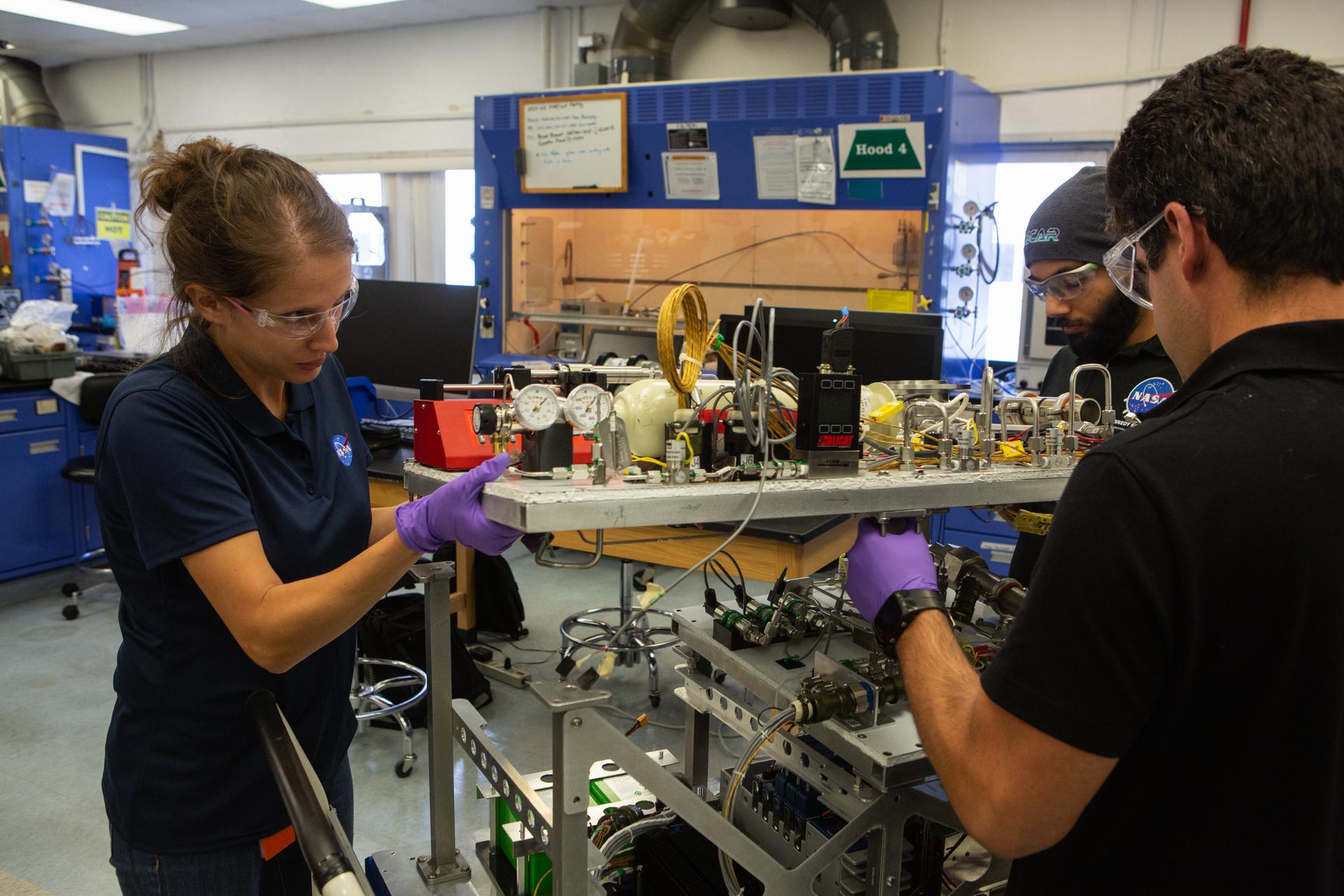 From left, team members Annie Meier, Malay Shah, and Jamie Toro assemble the flight hardware for NASA’s Orbital Syngas Commodity Augmentation Reactor, or OSCAR, on Oct. 10, 2019, in the Space Station Processing Facility at the agency’s Kennedy Space Center in Florida. OSCAR began as an Early Career Initiative project at the spaceport that studies technology to convert trash and human waste into useful gasses such as methane, hydrogen, and carbon dioxide. NASA/Cory Huston There’s no “I” in team, and that holds true for NASA and its partners as the agency ramps up efforts to recruit tenured professors to research science for a semester at the agency’s Kennedy Space Center in Florida. The tenured teachers work for up to a year in an area where the agency needs specific expertise.
From left, team members Annie Meier, Malay Shah, and Jamie Toro assemble the flight hardware for NASA’s Orbital Syngas Commodity Augmentation Reactor, or OSCAR, on Oct. 10, 2019, in the Space Station Processing Facility at the agency’s Kennedy Space Center in Florida. OSCAR began as an Early Career Initiative project at the spaceport that studies technology to convert trash and human waste into useful gasses such as methane, hydrogen, and carbon dioxide. NASA/Cory Huston There’s no “I” in team, and that holds true for NASA and its partners as the agency ramps up efforts to recruit tenured professors to research science for a semester at the agency’s Kennedy Space Center in Florida. The tenured teachers work for up to a year in an area where the agency needs specific expertise.
NASA often finds tenured professors – someone who has been guaranteed a job with their university until they retire – through seminars or publications. Assignments must be mutually beneficial to the agency and organizations involved.
“At NASA, we want researchers who are doing something that could help us, that could be synergistic, and to not reinvent the wheel,” said Dr. Jose Nuñez, University Partnerships and Small Sat Capabilities manager at NASA Kennedy. “The goal is to find professors who can benefit the agency in an area that needs more research.”
The U.S. government’s Intergovernmental Personnel Act Mobility Program allows the temporary assignment of personnel between the federal, state, local governments, colleges and universities, Indian tribal governments, federally funded research and development centers, and other eligible organizations.
Dr. Reza Toufiq, an associate professor of chemical engineering at Florida Institute of Technology in Melbourne, Florida, is the first professor to leverage school funds to spend a semester at NASA Kennedy and work on projects dealing with waste and resource recovery.
Toufiq specializes in how to convert everyday trash into energy, including the ash or char left behind from thermally treated trash. He worked with Dr. Annie Meier, who leads a team that converts astronauts’ trash into gasses that can be used for fuel.
 Flight hardware for NASA’s Orbital Syngas Commodity Augmentation Reactor, or OSCAR, is inside the Applied Physics Lab inside the Neil Armstrong Operations and Checkout Facility at the agency’s Kennedy Space Center in Florida on July 21, 2022. By processing small pieces of trash in a high-temperature reactor, OSCAR is advancing new and innovative technology for managing waste in space. NASA/Kim Shiflett “I wanted to learn on the terrestrial side how we can infuse some of our technology, and he wanted to learn from us to grow into the space sector, so it was a really cool match,” said Meier, technical lead for situ resource utilization and waste management resource recovery systems at NASA Kennedy.
Flight hardware for NASA’s Orbital Syngas Commodity Augmentation Reactor, or OSCAR, is inside the Applied Physics Lab inside the Neil Armstrong Operations and Checkout Facility at the agency’s Kennedy Space Center in Florida on July 21, 2022. By processing small pieces of trash in a high-temperature reactor, OSCAR is advancing new and innovative technology for managing waste in space. NASA/Kim Shiflett “I wanted to learn on the terrestrial side how we can infuse some of our technology, and he wanted to learn from us to grow into the space sector, so it was a really cool match,” said Meier, technical lead for situ resource utilization and waste management resource recovery systems at NASA Kennedy.
Although Toufiq’s sabbatical with NASA is over, his work is not. Meier just received approval for a project through a Space Act Agreement, which allows a research sponsor to use NASA scientists and facilities to benefit both parties. Meier and other researchers at NASA will give Toufiq information on space waste products and lunar regolith stimulants; in turn, he will do the testing, and provide data to the agency because some of that information is currently unknown.
“He’s learning a lot about the fundamentals of different things with waste that we aren’t really doing, so we lean on academia to get some of that information and offer a fresh perspective,” Meier said.
An intergovernmental assignment is generally approved for up to two years, but it can extend for up to six years with authorization. The length of the appointment also depends on the agency’s needs and university’s sabbatical guidelines, which could pay for one or more semesters.
The University Partnerships team now is working to bring on two professors to NASA Kennedy next semester.
“There are many tenured professors and universities who would like to come here, but we are careful to use due diligence to make sure what they’re doing is something that aligns with our research and technology interests,” Nuñez said.
To learn more about the wide range of research happening at the Florida spaceport, click here.


